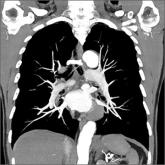Article

Best timing for measuring orthostatic vital signs?
- Author:
- Deborah Phipps, MD
- Erik Butler, DO
- Anne Mounsey, MD
- Michael M. Dickman, DO
- David Bury, DO
- Ashley Smith, MD, MBA
- Nick Bennett, DO, MBA
- Ben Arthur, MD, MBA
- Bob Marshall, MD, MPH, MISM
We typically take a blood pressure within 3 minutes of a patient rising from a supine to a standing position. But is that too long?
Article

A Better Approach to the Diagnosis of PE
- Author:
- Andrew H. Slattengren, DO
- Shailendra Prasad, MBBS, MPH
- David C. Bury, DO
- Michael M. Dickman, DO
- Nick Bennett, DO
- Ashley Smith, MD
- Robert Oh, MD, MPH, FAAFP
- Robert Marshall, MD, MPH, MISHM, FAAFP
A simple diagnostic algorithm is all that’s needed to safely and effectively reduce reliance on CT pulmonary angiography to diagnose pulmonary...
Article

A better approach to the diagnosis of PE
- Author:
- Andrew H. Slattengren, DO
- Shailendra Prasad, MBBS, MPH
- David C. Bury, DO
- Michael M. Dickman, DO
- Nick Bennett, DO
- Ashley Smith, MD
- Robert Oh, MD, MPH, FAAFP
- Robert Marshall, MD, MPH, MISHM, FAAFP
A simple diagnostic algorithm is all that’s needed to safely and effectively reduce our reliance on CT pulmonary angiography to diagnose PE.
